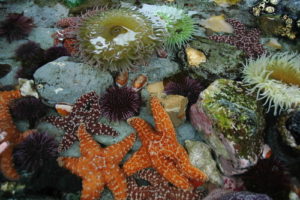If you’re looking for something to do, whether you’re a native or just visiting, the La Jolla Tide Pools are a great place to visit. It’s not only a beautiful and relaxing place to go, but it’s also surrounded by the festive downtown La Jolla scene and surrounded by various parks. On a typical day you would find, surfers, sailors, kite flying, families, and even local students checking out the varied marine life.
It’s a different vibe than the typical beach scene, as many people are enjoying the wildlife and calm waters washing up into the pockets of smooth rocks that create this beautiful landscape. Children and adults alike find excitement on how close you can be to nature where there is so much diversity.
Probably the first animals you will notice are the sea lions. Many sea lions have found a home in the Children’s Pool, where the wall creates a safe environment for young sea lion families. And the La Jolla Cove has a unique microclimate that stays between 50 to 90 degrees all year round, creating a comfort zone for wildlife. While many visitors find fascination with the ability to be close to these fun animals, there are warnings posted around the compounds to not get too close, harass, or try to feed them; they’re still wild.
However, where you will find the vast majority of La Jolla’s wildlife are in the micro-communities that call the La Jolla Tide Pools their home. Some anemone and muscles you might find right away, and others you have to wait and adjust your eyes to see several tiny fish, crabs, and starfish. The Scripp’s Institute made a fun pamphlet on what to find that makes it easy for anyone to identify the wildlife. Many of the creatures have specially evolved to thrive in high tide, and survive the sun and birds during low tide. And other species use these tide pools to lay their eggs, where the shallow water protects their young. A fun way to find elusive creatures, like the brittle starfish, is to gently lift rocks and slowly set them back. Just remember to be careful where you step and not to disturb the wildlife by picking them up or trying to take them home.



Recent Comments